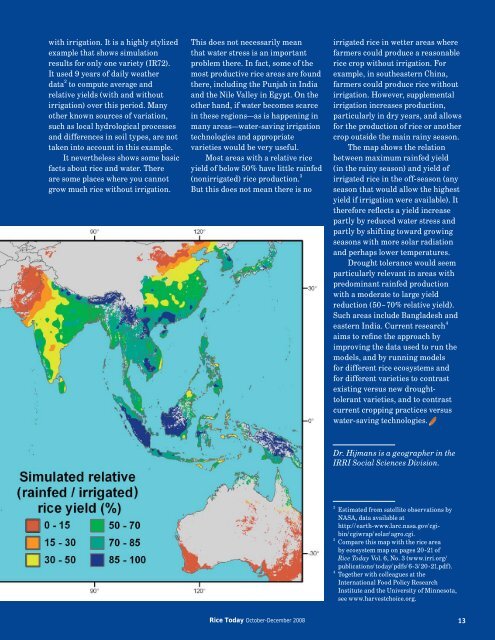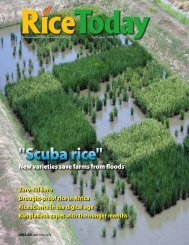with irrigation. It is a highly stylizedexample that shows simulationresults for only one variety (IR72).It used 9 years of daily weatherdata 2 to compute average andrelative yields (with and withoutirrigation) over this period. Manyother known sources of variation,such as local hydrological processesand differences in soil types, are nottaken into account in this example.It nevertheless shows some basicfacts about rice and water. Thereare some places where you cannotgrow much rice without irrigation.This does not necessarily meanthat water stress is an importantproblem there. In fact, some of themost productive rice areas are foundthere, including the Punjab in Indiaand the Nile Valley in Egypt. On theother hand, if water becomes scarcein these regions—as is happening inmany areas—water-saving irrigationtechnologies and appropriatevarieties would be very useful.Most areas with a relative riceyield of below 50% have little rainfed(nonirrigated) rice production. 3But this does not mean there is noirrigated rice in wetter areas wherefarmers could produce a reasonablerice crop without irrigation. Forexample, in southeastern China,farmers could produce rice withoutirrigation. However, supplementalirrigation increases production,particularly in dry years, and allowsfor the production of rice or anothercrop outside the main rainy season.The map shows the relationbetween maximum rainfed yield(in the rainy season) and yield ofirrigated rice in the off-season (anyseason that would allow the highestyield if irrigation were available). Ittherefore reflects a yield increasepartly by reduced water stress andpartly by shifting toward growingseasons with more solar radiationand perhaps lower temperatures.Drought tolerance would seemparticularly relevant in areas withpredominant rainfed productionwith a moderate to large yieldreduction (50–70% relative yield).Such areas include Bangladesh andeastern India. Current research 4aims to refine the approach byimproving the data used to run themodels, and by running modelsfor different rice ecosystems andfor different varieties to contrastexisting versus new droughttolerantvarieties, and to contrastcurrent cropping practices versuswater-saving technologies.Dr. Hijmans is a geographer in theIRRI Social Sciences Division.2Estimated from satellite observations byNASA, data available athttp://earth-www.larc.nasa.gov/cgibin/cgiwrap/solar/agro.cgi.3Compare this map with the rice areaby ecosystem map on pages 20-21 of<strong>Rice</strong> <strong>Today</strong> Vol. 6, No. 3 (www.irri.org/publications/today/pdfs/6-3/20-21.pdf).4Together with colleagues at theInternational Food Policy ResearchInstitute and the University of Minnesota,see www.harvestchoice.org.<strong>Rice</strong> <strong>Today</strong> October-December 2008 13RT7-4 (p1-23)_FA.indd 1310/9/2008 8:24:17 AM
A FLOUR BLOOMSby Masaru Yamada and Satomi Tamai in TokyoSTARBUCKS COFFEE JAPAN<strong>Rice</strong> flour-based products are booming in Japan, forcing the country to changethe way it thinks about agricultureYuko Kimura, a chef atFukusoen, a traditionalnoodle restaurant inTsuruoka City in YamagataPrefecture, is riding the crestof a wave. After launching the“Haenuki Men” rice noodle in June2007, Fukusoen, owned by a localagricultural cooperative known asJA, sold 18,000 of the meals by theend of March 2008. Then, from Aprilto June 2008, the restaurant soldalmost the same amount again.Instead of soba, the traditionalbuckwheat used for noodles, riceflour is the main ingredient ofHaenuki Men noodles. By addingsome starch from a domestic potato,says Kimura, “We could develop anoodle with a great texture that isn’tavailable with traditional soba.”With rice-flour noodlesgaining popularity, riceconsumption in Japanhas increased. Theamount of rice destinedfor noodles is overtakingthat used for breads. <strong>Rice</strong>flour began to be usedfor breads about 5years ago as partof a Japaneseschool lunchprogram developedto encourageA NEW rice-flour productlaunched by YamazakiBakery company, thebiggest bread maker inJapan.YAMAZAKI BAKERYthe use of locally produced food,including vegetables and rice. Withlocal government support, morethan 8,000 schools—one-thirdof all lunch-serving schools inJapan—serve rice-flour breads now.And the trend is not limited tothe public sector, with an increasingnumber of private companiesalso interested in rice flour.Lawson, a company that owns 24-hour convenience stores, announcedearlier this year that they wouldbegin to sell rice-flour breads ataround 8,500 shops from September.In Japan, the new demand forproducts such as those made fromrice flour is currently responsible forthe consumption of around 6,000tons of rice per year. It is believedthat Lawson’s contribution alonewill more than double this figure.Yamazaki Bakery, a majorbaking company that alsosells rice-flour breads, hasexpanded its market to thewhole of Japan, selling about50,000 loaves of rice-flour breadper month. According to aYamazaki representative,“The novelty of usingrice flour and the useof local rice appealto consumers. Weplan to offer a rangeof rice-flour breads.”Improvements inmilling technology areextending the advantagesof rice flour. The finerit is milled, the “stickier”A NEW RICE noodle product, which won a prize inthe national food contest held by the agriculturalministry in 2007.rice flour becomes—a property thatgels with consumer tastes. In thislight, Starbucks Coffee Japan beganoffering rice-flour rolls in June.“The sticky taste goes withcoffee very well,” says a Starbucksspokesperson. “And, because wheathas become much more expensive,the price difference between wheatand rice flour has dwindled.”This point underlies the factthat Japan, which is self-sufficientin rice but must import much ofits wheat, was not directly affectedby the rice-price spike in 2008.<strong>Rice</strong> flour itself is not newto Japan, which has a history ofthousands of years of rice production.However, breads, noodles, cakes,and many other products previouslythought to require wheat as amain ingredient are now beingmade from rice flour—and theyare gaining great favor in Japan.So, what are the reasons?MASARU YAMADA14 <strong>Rice</strong> <strong>Today</strong> October-December 2008RT7-4 (p1-23)_FA.indd 1410/9/2008 8:24:19 AM
















